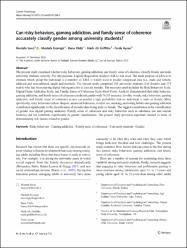| dc.contributor.author | Çelik, Deniz | |
| dc.contributor.author | Duyar, Sezgi Şahin | |
| dc.contributor.author | Aksu, Funda | |
| dc.contributor.author | Fırat, Selma | |
| dc.contributor.author | Çiftçi, Bülent | |
| dc.date.accessioned | 2022-09-23T14:01:00Z | |
| dc.date.available | 2022-09-23T14:01:00Z | |
| dc.date.issued | 2021 | en_US |
| dc.identifier.uri | https://hdl.handle.net/20.500.12868/1678 | |
| dc.description.abstract | Background and Objectives: It is known that the prevalence of obstructive sleep apnea (OSA) is increased in acromegaly. Craniofacial anomalies, macroglossia, and thickening of the laryngeal wall caused by the increase in soft tissue in these patients lead to OSA. Also, the increase in growth hormone can trigger central apnea by causing a decrease in respiratory drive. Determining the polysomnographic characteristics of acromegaly patients is important to reveal the effect of these mechanisms.
Methods: The demographic and polysomnographic characteristics of 33 acromegaly patients who underwent polysomnography (PSG) with suspicion of sleep disorders between 2011 and 2018 in the sleep laboratory of our hospital were retrospectively analyzed. One of the patients was excluded from the analysis because PSG was performed in the postoperative period. The remaining 32 patients with active acromegaly were grouped according to their gender and the presence of OSA and compared with statistical methods in terms of polysomnographic and clinical features.
Results: OSA (AHI>5) was detected in 78.1% of 32 active acromegaly patients (18 females, 14 males) who underwent PSG with suspicion of sleep-disordered breathing. Moderate-severe OSA (62.5%) was found in most patients, and there was no difference between the sexes in terms of OSA detection rate and OSA severity. Respiratory events appear to be predominantly obstructive hypopneas. Also, the polysomnographic features of female and male acromegaly patients with OSA were found to be similar. It is seen that the OSA group is similar to the group with simple snoring in terms of body mass index (BMI), but is statistically significantly older (p=0,007). A positive correlation was found between age and AHI in pairwise correlation analysis (r:0,426 p:0,015, respectively).
Conclusion: Considering that the prevalence of OSA in the population is approximately 5%, our results show that the risk of OSA in acromegaly increases, and obstructive pathways are effective in this increase. The probability of OSA occurrence and polysomnographic features between the genders are similar. Although the median BMI of the patients with and without OSA was similar, the median age was higher in the group with OSA, middle-aged acromegaly patients should be evaluated in terms of OSA even if there is no obvious obesity. | en_US |
| dc.language.iso | eng | en_US |
| dc.relation.isversionof | 10.12669/pjms.37.4.4229 | en_US |
| dc.rights | info:eu-repo/semantics/openAccess | en_US |
| dc.subject | Acromegaly | en_US |
| dc.subject | Obstructive sleep apnea | en_US |
| dc.subject | Respiratory | en_US |
| dc.title | Evaluation of Acromegaly patients with sleep disturbance related symptoms | en_US |
| dc.type | article | en_US |
| dc.contributor.department | ALKÜ, Fakülteler, Tıp Fakültesi, Dahili Tıp Bilimleri Bölümü | en_US |
| dc.identifier.volume | 37 | en_US |
| dc.identifier.issue | 4 | en_US |
| dc.identifier.startpage | 1161 | en_US |
| dc.identifier.endpage | 1165 | en_US |
| dc.relation.journal | Pakistan Journal of Medical Sciences | en_US |
| dc.relation.publicationcategory | Makale - Uluslararası Hakemli Dergi - Kurum Öğretim Elemanı | en_US |


















